Gas exchange and stomatal physiology- LECTURE 1
1/43
There's no tags or description
Looks like no tags are added yet.
Name | Mastery | Learn | Test | Matching | Spaced |
|---|
No study sessions yet.
44 Terms
Leaf strucutre
Waxy impermeable cuticle
made of cutin
Upper epidermis (adaxial)
mesophyll cell tissue
Lower epidermis (abaxial)
With stomata pores across the leaf surfaces
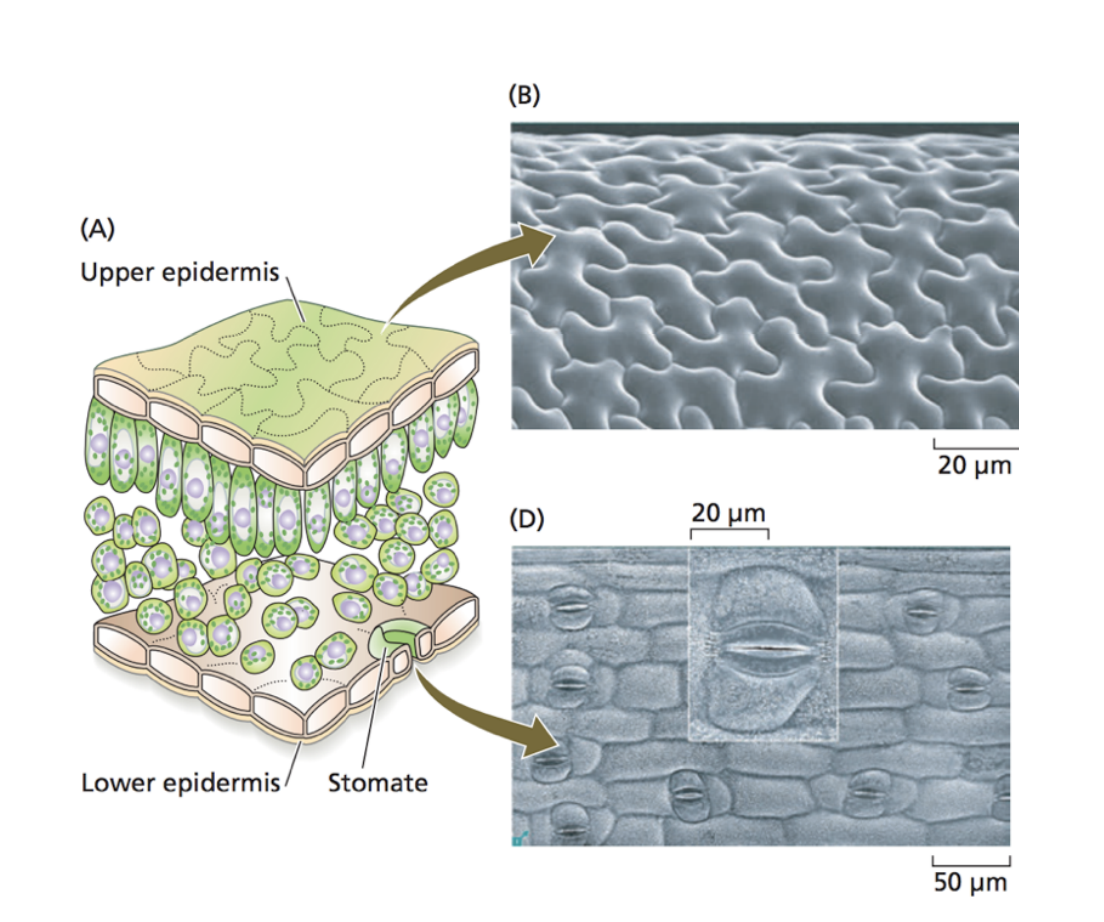
Advantages of this strucutre
Prevent water loss
essential to allow plants to become terrestrial
But does not limit gas exchange
stomata are controllable values to allow gas exchange
CO2, O2 and water vapour
Also allows evaporative cooling!
Transpiration!
OVERALL: can easily balance water loss
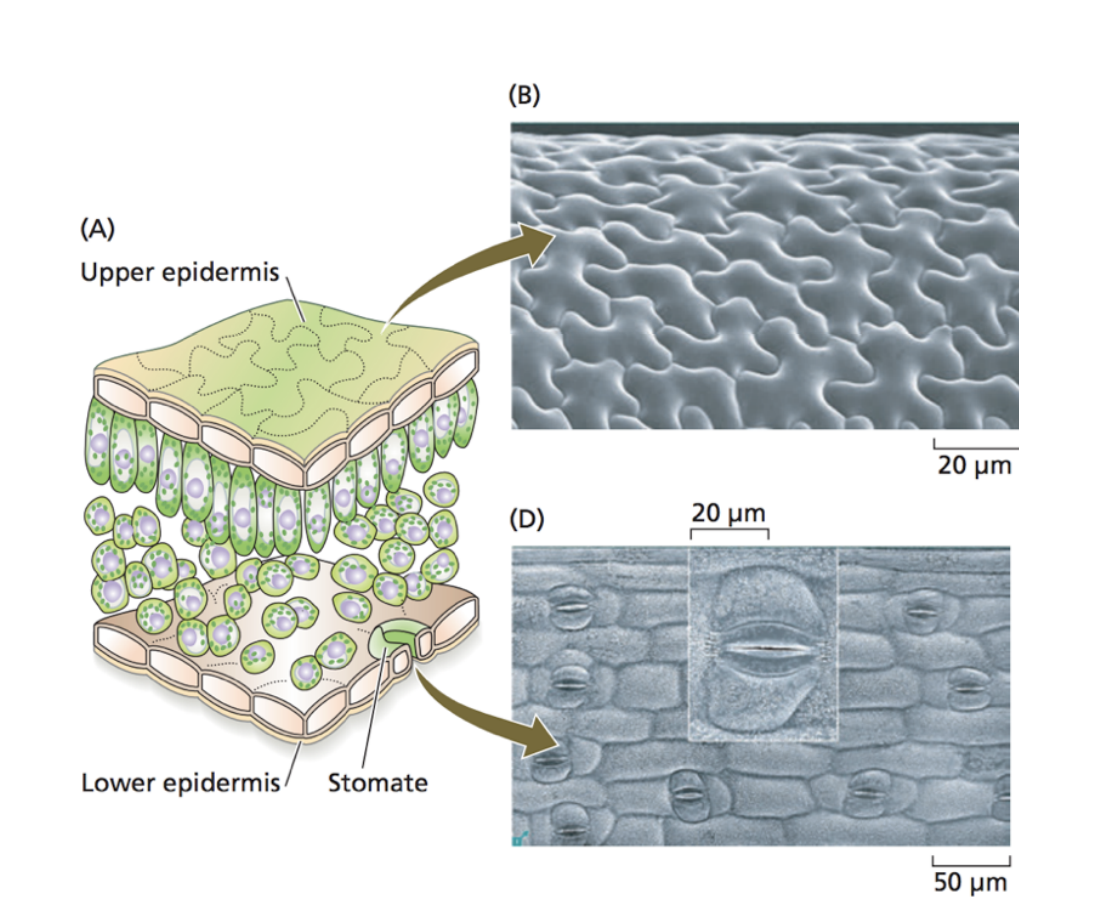
Balance of stomata
Good for:
CO2 in
O2 out
H2O out→
evaporative cooling
transpiration
Bad for:
too much water loss!
Therefore need a balance between these→ must be controlled!!
Importance of stomata
120Gt of carbon
twice atmospheric water vapour content
all exchanged through stomatal pores
Terristrial plants fix 15% of the atmospheric pool of carbon each year
through photosynthesis
Stomatal form
stomtal pore
flanked by a pair of guard cells (GC)
‘flanked’→ on each of the sides
Types of guard cells
(most) Dicots
‘sausage -shaped’ GC
Monocots (grasses)
dumb-bell shaped
with an array of flanking subsidiary cells (SC)
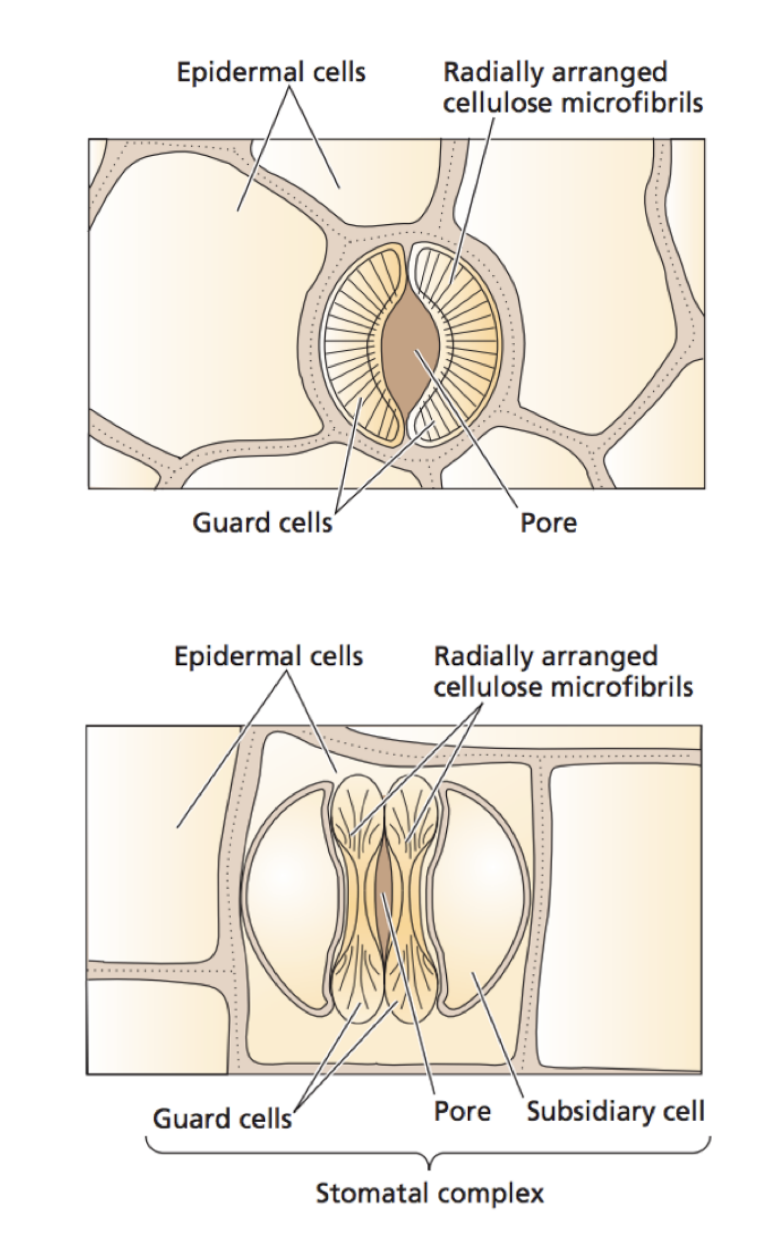
Over several hundred million years
stomata have remained relatively unchanged in basic form
Special case stomata→ Commelina communis
sausage shaped guard cells
and
subsidiary cells
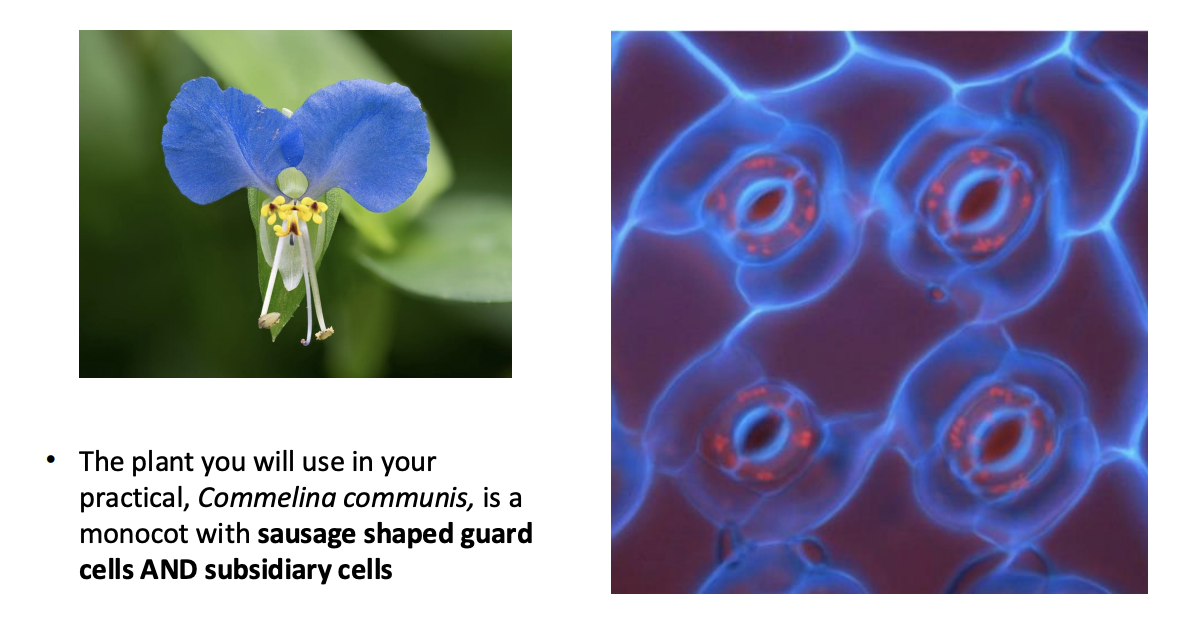
Stomatal pore opening and closing depends on
Respond to changing envirionment
soil water availability
evaporative demand
air vapour pressure
Co2 concentrations
light intensity
What drives the opening process
Guard cell turgor
generated vis accumulation os osmotically active solutes
causes water to flow into the guard cells from surrounding tissues
phiw=phis +phip
Recap of water potential
→ Water potential: water moves fown gradient of free energy
converted into pressure
always negative (unless hot or under pressure)
→ solute potential
addition of solutes to pure water reduced delta G
water wraps themselves around hydration shell around ions
numerically equivalent to osmotic pressure +pi
→ Hydrostatic or turgor pressure
positive tugour exerted within cells
to provide rigidity
difference between water and solute potential
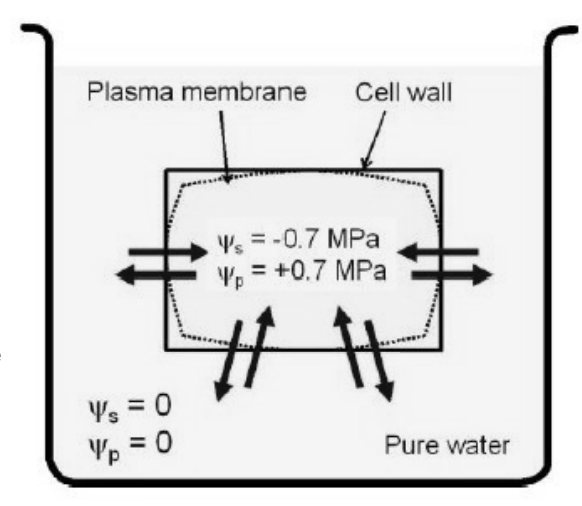
Also additional factors that defines the free energy status of water on pores and cell wall matrices
In dry soils or cell walls
Matric potential phiM
How do changes in turgor pressure in GC cause opening?
Due to ultrastructure of cell wall
cell wall thickening
cellulose microfibril orientation
→ causes GCs to become rounder with increased pressure
→ Open aperture
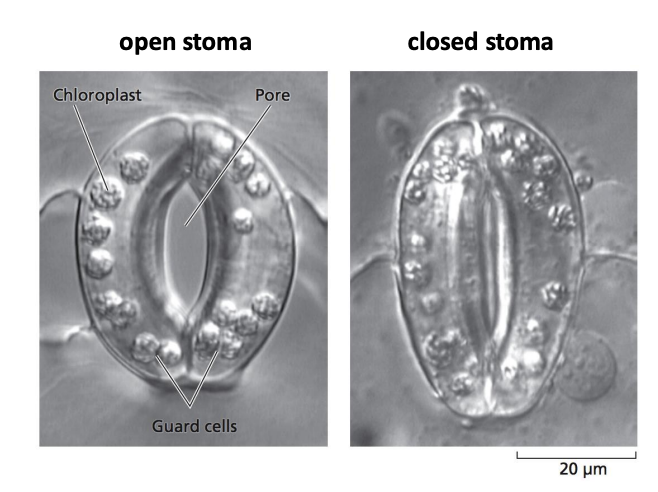
Antagonism between guard cells and epidermal cells
Guard cells become turgid
Become rounder and open stomata
Pop up and out of the epidermal plant
Easy to see they have popped up and out compared to epidermal cells surrounding
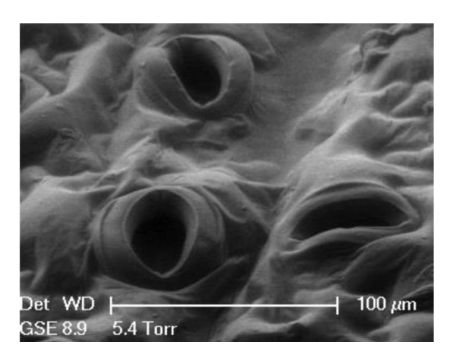
Mechanical Advantage
Guard cell expansion is limited by the
antagonism of adjacent epidermal cell turgor
whereas Subsidiary Cells act as ion reservoirs
reciprocate turgor loss with GC turgor gain, improving stomatal sensitivity and rapidity.
What do subsidiary cells do?
Helps overcome mechanical advantage imposed by epidermal cell turgor
Reciprocal exchange of solutes between GCs and SCs
allow a “push-pull” system
Potentially improves sensitivity to the enviornment
allows grass stomata to react faster
How does this work (simplified)?
e.g
When opening
guard cells can expand
into relaxed subsidiary cells when opening
When closing
Subsidiary cells push
guard cells shut
Compared to just suasage shaped cells
More efficient control of pushing the stomatal in and out
don’t have to pop up and out as much
pushed and pulled together!
improves sensitivity to environment
don’t have to overcome the epidermal cells and really push out the guard cells like before?
Mechanism for stomatal opening
Activation of plasma membrane “P-type H+-ATPase”
pumps H+ out of cell into apoplast
Creates hyperpolarisation on the outside
Causes Passive uptake of K+
To maintain electroneutralilty, causes:
uptake of Cl- and H+ via a symporter
synthesis of malate2- in the cytosol
Co2→OAA→malate2-
Solute accumulation causes water to flow in
opens the stoma

Concentrations of K+ and Cl- transporter
350mM K+
90mM Cl-
Needed to drive the opening process
→ can be worked out using nernst equation:
blah blah blah
How to close stomata
Need to remove solutes, and allow water to leave
→ using Ca2+ signalling! (see lectures of other stuff this is used for, wounding etc)

Mechanism for stomatal closure
Ca2+ activates slow (S-type) ansion channel
Mediates Cl- efflux
Membrane depolarisation
Leads to K+ efflux
Ca2+ signalling also reduces acitivity of H+ ATPase
→ so stops the opening process too!
Malate2- concentrations also decrease
Less solute inside→ water is drawn out→ closes
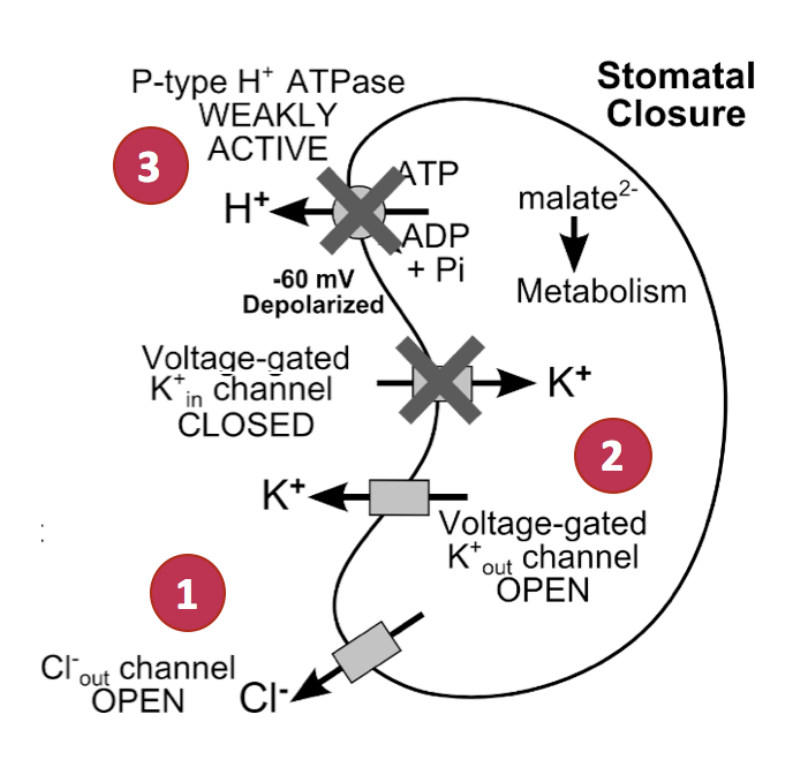
Do Ca2+ contribute to the solute potential??
NO
Concentrations are so low
it is used as a signalling agent only
What regulates stomatal pore opening/closing
Light
Water availability→ ABA
in response to stress
drought
salinity
CO2
Regulation by Light→ blue light signalling
Receptor:
phototropin
Response
promotes stomatal opening
Mediated by
P type H+-ATPase on the plasma membrane
Regulation by Light→ blue light signalling- in absence of light
C-terminal auto inhibitory domain of the ATP-ase inactivates the pump
by blocking the catalytic domain
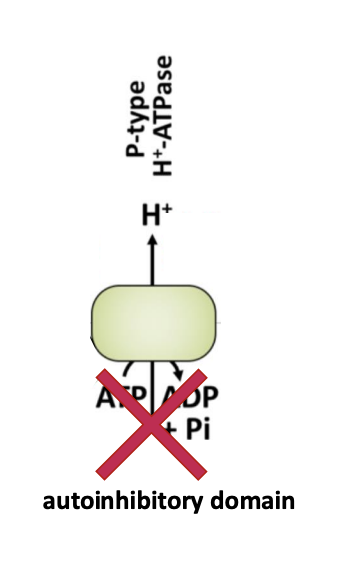
Regulation by Light→ blue light signalling- in response to blue light
Phototropin mediates phosphorylation of C-terminal domain
Domain is displaced from catalytic site
14-3-3 regulatory protein binds to phosphorylated domain
Makes sure it stays phosphorylated
keeps the proton pump activated
So proton pump can power the opening of the stomata etc
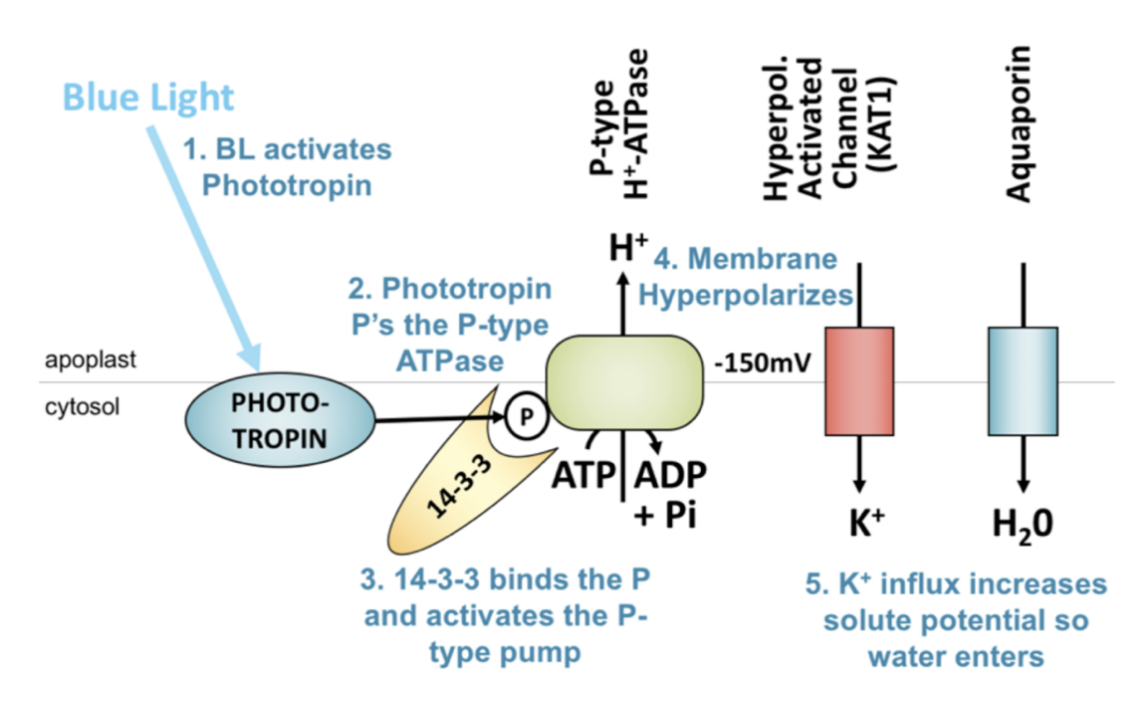
Regulation to drought→ why needed?
drought→ plant growth and productivity severely impaired
plants evolved to increase drought tolerance
→ One of the first responses:
close stomata so decrease water loss
Regulation to drought→ how detect drought?
Not really understood
Channel proteins and receptor like kinases involved?
Regulation to drought→ How response mediated?
Abscisic Acid (ABA)
accumulates in plant tissues
inhibits stomatal opening and promotes stomatal closure
Regulation to drought→ How ABA stomatal closure works
ABA binds to cytosolic receptor PYR1
Activates a MAP kinase phosphorylation cascade
Leads to release of internal and external pools of Ca2+
from vacuole and endoplasmic reticulum
Ca2+ activates or reinforces stomatal closure mechanism
from before: i.e removing solutes and water from GCs
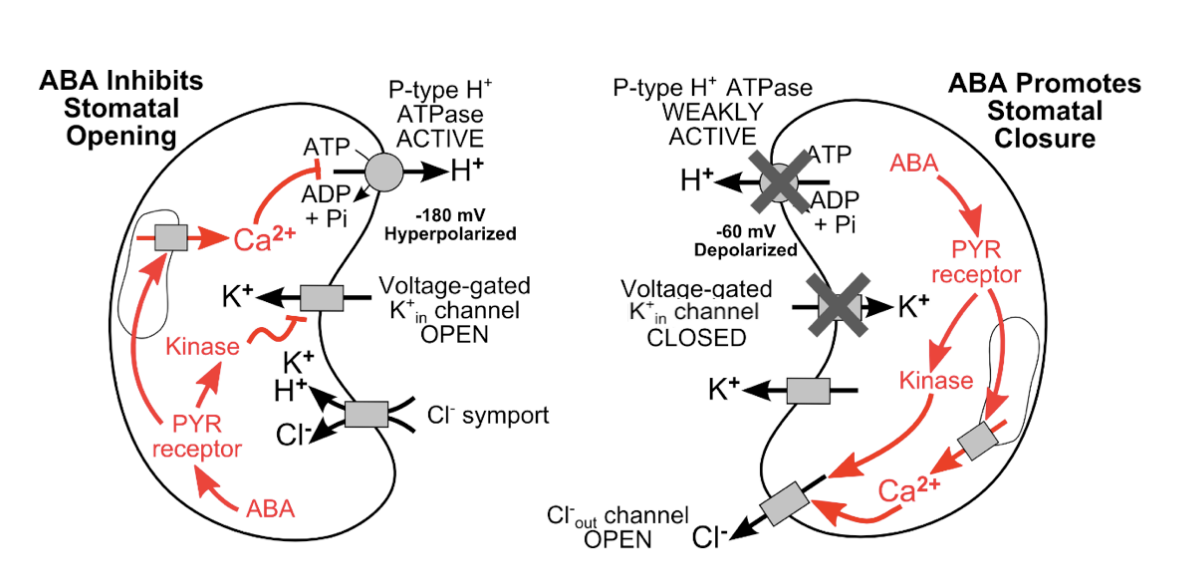
Latest evidence suggests
ABA triggers Ca2+ transients
temporary localised changes in [Ca2+]
well controlled
i.e pulses
![<p>ABA triggers Ca2+ transients</p><ul><li><p>temporary localised changes in [Ca2+]</p></li><li><p>well controlled</p><ul><li><p>i.e <em>pulses</em></p></li></ul></li></ul><p></p>](https://knowt-user-attachments.s3.amazonaws.com/ed18a237-3020-4214-ae93-90e4b852a5cb.png)
Magnitude and frequency of these pulses
Reflect the rate of the closing response is transduced

Subsidary cells enable…
Faster closing of stomata
→ recent genetic evidence for the role of subsidiary cells in maize leaves
during stomata response to ABA

Control of Water use→ where is ABA syntehsised
In plant plastids from carotenoid precursors in
Leaf chloroplasts
Root plastids
May provide sources to trigger GC responses
Plastids
membrane-bound organelles
differentiate into chloroplasts in leaves,
but may contain pigments in flowers or metabolite (starch) storage and mobilisation in roots
plastids are sites of ABA synthesis.
Control of water use→ where is ABA released in response to water deficits?
Root senses water deficits
ABA released from root plastids de novo
Into transpiration stream
→ To GC complexes in leavesduring evaporation
closes stomata
BUT also made locally in leaves
→ even before transport from the roots
Plant prepares itself already!!
Ca2+ fast signalling??
Why important to understand signalling→ commercial use
e.g Grapevines
Irrigated on both sides:
Top growth excessive
fruit quality reduced by shading
INSTEAD: Irrigating on alternate sides of plant:
ABA made on one half→ carried to leaves
top growth is reduced
fruit quality is maintained
Why useful?
reduces overall demand for irrigation
→ useful in warming drying climate
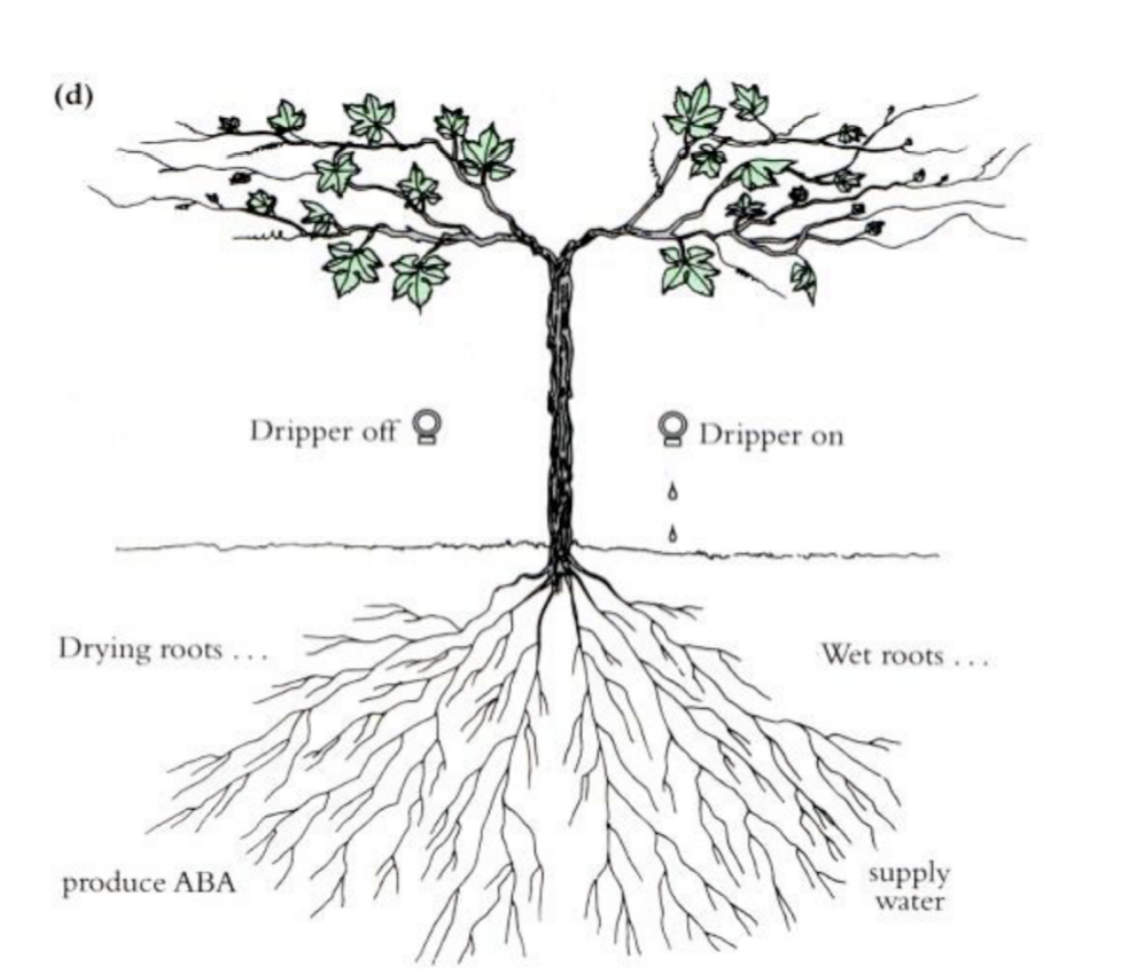
Stomatal opening mechanisms can be hijacked by pathogens
e.g Fusicoccum
produces toxin: fusicoccin
activates P-type H+-ATPase
causes stomatal opening
even when plant doesn’t want to
Causes plant wilting
opens them similar to blue light signalling through phototropin
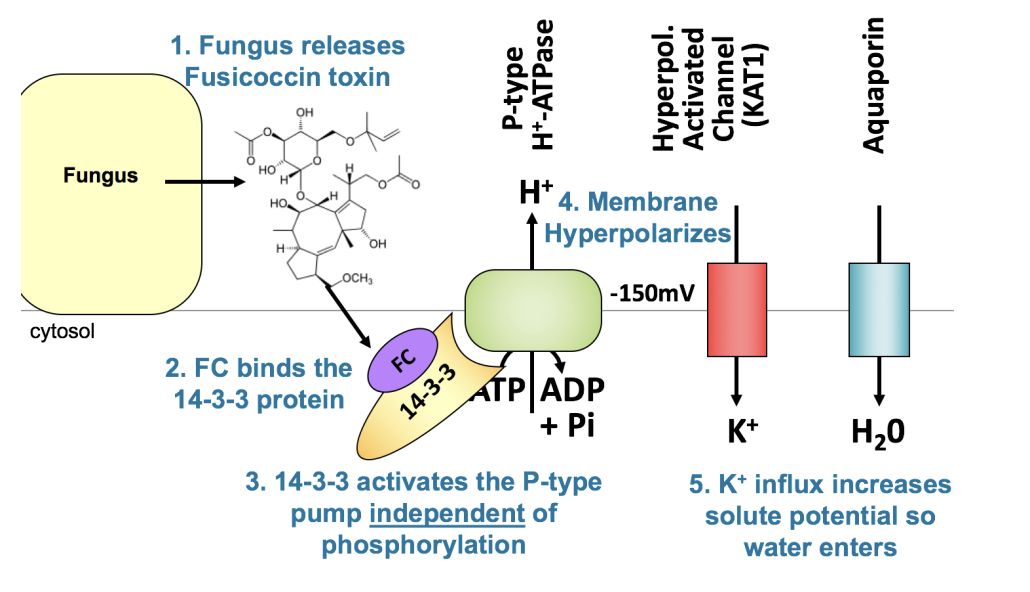
Environmental factors not only affect stomatal aperture but also…
Stomatal development
Young leaves develop:
environmental conditions sensed by plants
number and size of stomata are adjusted
cannot be changed once finished development programme
Plants that grow under high light and suffient water sonditions
Develop
higher stomatal density
larger stomata
Because Co2 exchange in the limiting factor
When plant grows in high CO2 concentrations
fewer stomata develop
→ do not need to open as much to get to the CO2
→ Have less stomata to decrease water loss
Water is the limiting factor
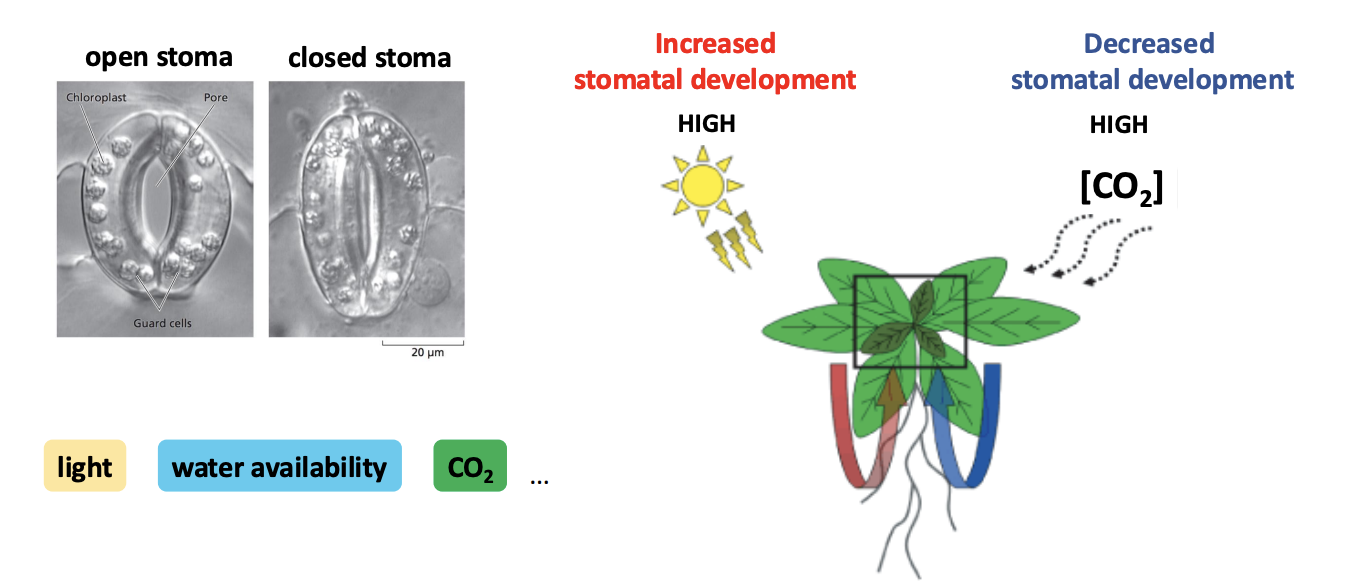
E.g Commelina Communis: High humidity, sufficient water
Large stomata
High Stomatal density
To maximise the Co2 uptake→ the limiting factor

E.g Succulent plants: Semi arid habitats, water limitation
small stomata
low stomatal density
because water is limiting factor→ need to limit its loss
(got sufficient amounts of CO2 (hopefully))
